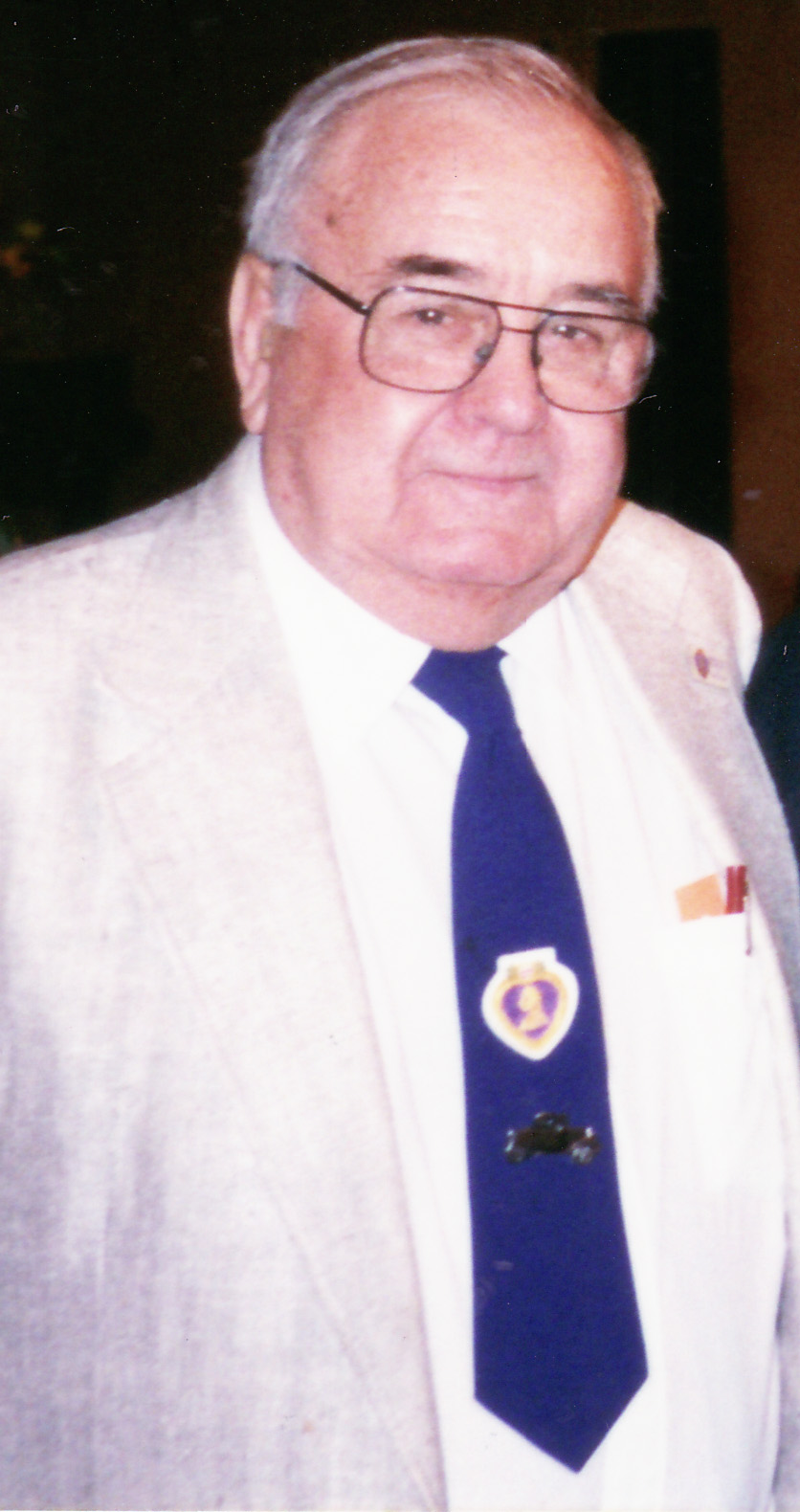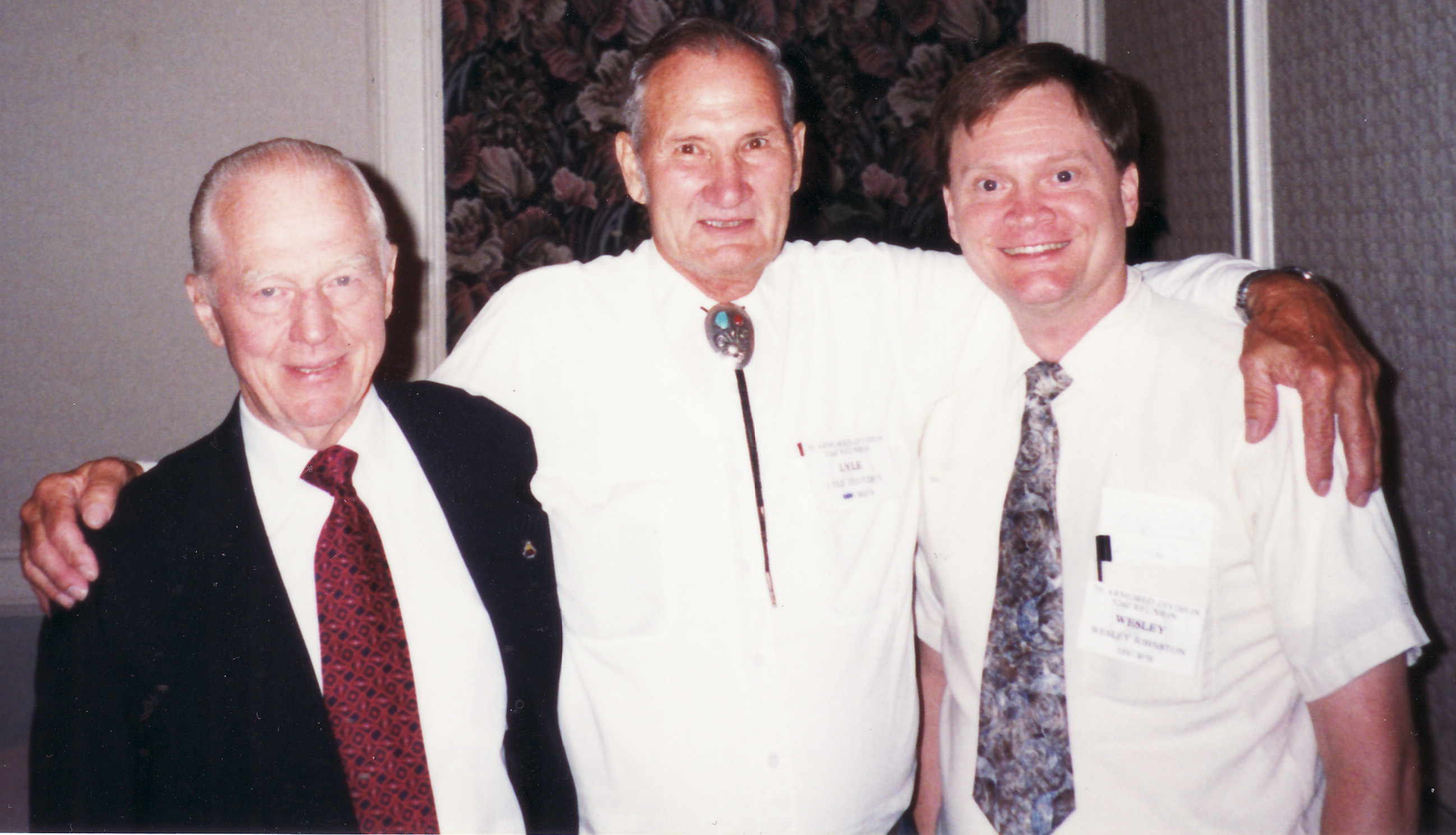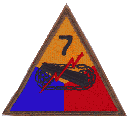Survivor Accounts
The accounts are presented in descending order of direct relevance. Bold text is not in the original text.
|
Personal Account of Pvt. Mack C. Harris (HQ Co/38) 29 Mar 1950
This is the most important record in the case of Maj. Wells. It is the only eye-witness account of his death. It is not from his IDPF but from the IDPF (PDF p 32) of S/Sgt. Charles W. Shenk who was Supply Sergeant for Headquarters Company, 38th Armored Infantry Battalion. Pvt. Mack C. Harris was one of about 40 men cut off in Sillegny by German artillery, preventing their withdrawal or relief. They were all then captured. No 38 AIB personnel who survived the action, other than the captured men, saw what had happened to Maj. Wells, although 1st Lt. Carl Mattocks, CO of the Headquaters Company Assault Gun Platoon, apparently did see it about to happen and see it after it happened but could not be sure what had happened. (See his account below.)
IMPORTANT NOTE: The dates of events in the 1950 statements of Capt. McAdams and Pvt. Harris are clearly one day after the actual dates. Maj. Wells was definitely killed 19 Sep 1944. The statements 5 1/2 years after the fact seem to have been biased by some suggestion from a common source that erroneously believed that Charles Shenk was lost 20 Sep. But Shenk and Harris and McAdams all showed in the 22 Sep 1944 Headquarters Company Morning Report as MIA as of 19 Sep, along with T/Sgt. Hanson, S/Sgt. Clarkson, and Cpl. Cochran and Pfc. Mrozowski.
1950 Mar 29 Statement of Private Mack C. Harris
On this date Sept. 20 [sic] - 1944 Capt. McAdams S/Sgt Shenk and myself were directing artillery & mortar fire on Sillegny, France. Capt. McAdams was inside the house, useing [sic] the radio trying to contact help or aid, (Major Wells of 38 Armd. Infm Bn.) (S/Sgt Shenk) (1st Lt. White, & a Sgt. I never knew out of an Engineer outfit) were at the back of the house, I was at the side of the house, an enemy mortar shell hit the wall just over the heads of these men. Major Wells of 38 Armd. Inf. Bn. Hq was killed out right - 1st Lt. White & the Sgt. out of the Engineer outfit were also killed, S/Sgt Shenk was badly wounded, he was hit in the lower part of the body, the groin & stomache [sic], the wounds were severly. [sic] I helped to get him into the house, there was a medical aid man there but he had very limited sipplies. [sic] He did the best he could for S/Sgt Shenk in the way of aid - this was between 4 & 6 oclock [sic] in the evening. S/Sgt. Shenk was delirious. We did every thing possible to make him comfortable. So the Germans marched in on us some time between 11oo & 2oo oclock [sic]. We took down a door for a stretcher & took Sgt Shenk with us.
The German marched the group for about 3 hours - about 8 or 9 miles, we finaly [sic] were herded in to a barn, there was a German Dr. he was aksing if any one was wounded. Several of the boys and my self had minor wounds, we took Sgt Shenk in a small room and the Dr. sent the rest of us up stairs, in about an hour they the groupe [sic] together again to continue our treak [sic] into Germany. So we called for S/Sgt Shenk. The Dr. said he had passed away. So we had to leave him there - I am sure all of his papers & pay book & dog tags were on him -
I have never spoke of this before to any one, I had presumed the Germans had notified the U. S. Government.
7th Armored Division Association Historian Wesley Johnston evaluation:
- As noted prior to the statement, the dates are one day after the actual dates.
- The medical aid man may have been Pvt. Havery E. Malamud of the 38 AIB Medical Detachment, whose remains were recovered at Sillegny in November 1944. He is the only casualty listed for 19 Sep 1944 in the Med/38 Morning Reports. If he was the medic attending the men in the house, then he was killed at some point. His Report of Burial (19 Nov 1944 at Limey) shows that he had received a gunshot wound to the right chest. If he was indeed the one in the house, then it is possible that when he was recovered Maj. Wells was also recovered and taken to Limey as an Unknown. This would conflict with the statement of Captain Robert Kinoshita (below) who told his son that he had seen the remains of Maj. Wells which would indicate that they were evacuated during the events of the next couple of days at Sillegny, in which case they would probably have been taken to the temporary cemetery at Andilly.
- There was no officer named White in 38th Armored Infantry Battalion. It is unclear from the account, but it seems that 1st Lt. White may have been in "an engineer outfit". I do not have the complete list of 33rd Armored Engineer Battalion personnel, but Company "C" of 33 AEB was the only known engineer unit involved in the attack on Sillegny, which was entirely a Combat Command "R" operation on 19 Sep 1944, and the CCR After Action Reports show no other engineer unit in the task forces. There was no officer named White who died in the war as a member of 7th Armored Division. So it seems that either Pvt. Harris mis-remembered (5 1/2 years after the fact) the name of the officer or else he thought that the officer was killed but he was not. The C/33 Morning Reports show only one 1st Lieutenant was on duty on 18 Sep 1944 and that he was killed 19 Sep 1944. He was 1st Lt. Thomas S. King, Jr. whose remains were recovered either the same or the next day (19 or 20 Sep) and buried at Andilly 21 Sep. If 1st Lt. King was the one identified as 1st Lt. White, then his recovery to Andilly would indicate a probability that Maj. Wells was also taken to Andilly.
- Only one C/33 Sergeant was killed 19 Sep. Sgt. Eugene E. Stoesser (whose IDPF I do not have) was reported by C/33 buddy Howard H. Gregory (in a letter to his [Gregory's] sister) to have been wounded by the same grenade that killed Sgt. Stoesser, which would rule Stoesser out as being killed in the way that Pvt. Harris provided in his statement for the death of the engineer Sergeant -- unless Howar Gregory was wrong about the explosion being from a hand grenade. There was also a C/33 Tec 4 killed, who would have been referred to as Sgt. Tec 4 Canio Joseph Civita was recovered from Sillegny in February 1945 and buried at the temporary cemetery at Hamm, Luxembourg. However there were two Sergeants killed from Headquarters Company of 33 AEB. S/Sgt. Leo R. Worthington has never been found and identified, but he was seen to have died at the Seille River on reconnaissance for a bridge site so that he could not be the engineer Sergeant in the account of Pvt. Harris. The other is S/Sgt. Charles C. Panion, whose IDPF I do not have. But the HQ Co/33 Morning Report of 20 Sep 1944 shows Panion and Worthington KIA and states "2 EM KIA 1/2 Mi E of Sillegny, Fr on Seille River while on Rcn mission." So if the engineer Sgt. was from 33 AEB, it was either Stoesser (in which case Gregory was wrong that it was a grenade) or Civita.
|
Personal Account of 1st Lt. (later Capt.) Carl K. Mattocks (CO AG/HQ Co/38) September 1998

Carl Mattocks at 1998 Reunion
1st Lt. Carl K. Mattocks commanded the Assault Gun Platoon of Headquarters Company, 38th Armored Infantry Battalion, at Sillegny. After his commandning officer Capt. Sam McAdams, CO of HQ Company, was captured at Sillegny, Mattocks assumed command of HQ Company and was later promoted to Captain and served as HQ Company CO for the duration of the war. Thus he was one of the few original 38 AIB officers to still be there at the end of the war.
After the war, Carl Mattocks made several trips to Europe and visited Sillegny. Thus he was familiar with the post-war configuration of the town as well as at the time of combat.
Immediately following the September 1998 annual reunion of the 7th Armored Division Association, Association Historian Wesley Johnston traveled to Europe to retrace the route of 7th Armored Division in France, Belgium and the Netherlands. So during the reunion, he met with Carl Mattocks for an hour or two, in order to learn about the places the Division had been, including precise locations of events. The following account is from Wesley Johnston's record of that meeting.
Wesley Johnston NOTE: The following account is from my memory and not from my notes. So when I do check my notes, it is possible that some parts of this may require change. But the essence of the account is correct, even if some specifics may change.
September 1998 Account of Carl Mattocks regarding Maj. Thomas Wells
During the combat of the afternoon of 19 Sep 1944, the Assault Gun Platoon was in position north of the east-west road leading from the woods down the slope to Sillegny. 1st Lt. Mattocks was able to see Maj. Wells (who at that time was acting CO of the battalion after the deaths of the CO and XO). Maj. Wells was by what in 1998 was the tennis court, nearer to the main road junction than was Mattocks. A shell was coming in, and Mattocks ducked into his turret for protection. After the shell had hit, he stood back up in his turret and could no longer see Maj. Wells. He never saw him again.
7th Armored Division Association Historian Wesley Johnston evaluation:
- If the incoming round that caused Carl Mattocks to duck into his turret was the same as the round or came in at the same time as the round that killed Maj. Wells, then this account conforms with that of Pvt. Harris as to the circumstances of the death of Maj. Wells.
- The account also conforms with the location of House A on the April 1946 recovery map (see Context section at top of this page for map) as the location where Maj. Wells was killed, since House A in 1944 was by where the tennis court (which by 2017 had been converted into a basketball court) was in 1998.
|
Personal Account of Capt. Robert Kinoshita (Bn Surgeon and CO/Med/38)

Robert Kinoshita during WWII
Capt. Robert Kinoshita was a medical doctor, serving as Battalion Surgeon of 38th Armored Infantry Battalion on 19 Sep 1944. The following account is second-hand. It is what he told to his son Richard Kinoshita who later told it to 7th Armored Division Association Historian Wesley Johnston.
Capt. Kinoshita did not stay behind the lines. He was up on the front lines and received Silver Star for his actions 16 Aug 1944 at Leves, France. He was recommended 18 Sep 1944 by Maj. Curtice Rankin, 38 AIB Executive Officer, for an oak leaf cluster for his Silver Star for his actions 17 Sep 1944 at Lorry, on the other side of the ridge west of Sillegny. (See the detail citations for his awards.) However, Maj. Rankin was killed the next day and the award was never made. Capt. Kinoshita also received the Purple Heart for both of the above actions and again for his action 21 Sep 1944 at Sillegny.
Capt. Kinoshita's awards are significant to his account, since the assumption that he was behind the lines at an aid station does not conform with him being up on the front lines, including at Sillegny.
Wesley Johnston NOTE: The following account is from my memory and not from my notes. So when I do check my notes, it is possible that some parts of this may require change. But the essence of the account is correct, even if some specifics may change.
Account of Robert Kinoshita regarding Maj. Thomas Wells
Capt. Kinoshita saw the remains of Maj. Wells by a building.
7th Armored Division Association Historian Wesley Johnston evaluation:
- Prior to this analysis, I had not taken into account that Capt. Kinoshita's modus operandi was very much to be at the front lines and not in the rear at an aid station. But you do not earn two Silver Star citations and three Purple Hearts in just over a month's time at an aid station. So my prior assumption that the building at which Capt. Kinoshita saw the remains of Maj. Wells was at an aid station or collecting point where they had been evacuated no longer fits with Capt. Kinshoita's m.o. In particular, the fact that just two days later, 21 Sep 1944, at Sillegny, Capt. Kinoshita was again wounded places does not fit with him being in the rear at Sillegny. So it is very possible that the building by which Capt. Kinoshita saw the remains of Maj. Wells was the building by which Maj. Wells had been standing when he was killed -- which the evidence points to as being the building identified as House A on the April 1946 recovery map (see Context section at the top of this page for the image of the map).
- In the days after 19 Sep, the Germans pulled back out of the town. On 22 Sep, 54 men of B/38 moved all the way through town to the Seille River, where they encountered strong enemy resistance and most of them were captured. The fact that they were able to move well past the location where Maj. Wells died clearly supports the interpretation of Capt. Kinoshita's statement as referring to the building by which Maj. Wells had been killed and still lay unrecovered.
- Three recoveries on the April 1946 map were not very far from "House A", which was the only building in the area and thus most probably where Maj. Wells died. And recoveries from Sillegny occurred several times over the weeks and months after the combat. So it is not clear if Maj. Wells' remains were recovered when 38 AIB was able to move through and beyond his position. The entire area was still a combat area, with the safety of the woods a mile away to the west, so that recovery of remains from the earlier days of combat was not likely to be a priority. However, due to his rank and to the high regard in which he was held, it may have been that the remains of Maj. Wells were recovered but that he somehow became an Unknown. If this scenario of recovery within a few days was the case, then he would have been taken to the temporary U. S. military cemetery at Andilly, France, as an Unknown.
|
Personal Account of Pvt. Lyle G. Zeutzius (HQ Company/38) September 1998

John Dean (Rcn/HQ Co/38), Lyle Zeutzius & Wesley Johnston at 1998 Reunion
Pvt. Lyle Zeutius was promoted 10 Oct 1944 to Tec 5 and transferred 13 Oct 1944 from Headquarters Company to Battalion Headquarters, in the S-2 (Intelligence) Section. On multiple occasions he told 7th Armored Division Association Historian Wesley Johnston the following account.
September 1998 Account of Carl Mattocks regarding Maj. Thomas Wells
After Maj. Wells was killed Lyle Zeutzius kept the helmet of Maj. Wells.
7th Armored Division Association Historian Wesley Johnston evaluation:
- This is clearly secondary information, not directly relevant to the event of the death or possible recovery of Maj. Wells, but it does confirm that the position at which he was killed was later reached by 38 AIB men, possibly on 20 or 21 Sep 1944. This conforms with Capt. Kinoshita being at that position and seeing the remains of Maj. Wells where he had been killed.
- Lyle Zeutzius could not recall how he had come to have the helmet nor how long he kept it, and I never asked him his reason for keeping the helmet.
|
|


